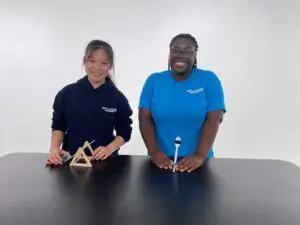 Elasticity: The ability of a material to return to its original shape after being stretched or pulled. Rubber bands have elastic characteristics.
Elasticity: The ability of a material to return to its original shape after being stretched or pulled. Rubber bands have elastic characteristics.
Kinetic energy: The energy of motion.
Iteration: The process of repeatedly testing and refining to reach a desired target or result.
Potential energy: Stored energy. Anything that isn’t moving but can has potential energy.
Prototype: An initial model of something from which other variations or innovations are developed.


 Make a set of identical trampoline bases. Each base needs to be rigid enough to support the fabric cutouts, as well as have an easy way for participants to attach and adjust the tension of the fabric cutouts. K’NEX pieces work well for this, as it’s easy to wrap cloth around K’NEX rods and secure them with clips. The trampoline frame shown below is one example, but you can create a different version. Or, if time allows, you can have participants design their own trampoline frame.
Make a set of identical trampoline bases. Each base needs to be rigid enough to support the fabric cutouts, as well as have an easy way for participants to attach and adjust the tension of the fabric cutouts. K’NEX pieces work well for this, as it’s easy to wrap cloth around K’NEX rods and secure them with clips. The trampoline frame shown below is one example, but you can create a different version. Or, if time allows, you can have participants design their own trampoline frame. Divide participants into small teams. Show teams the materials. Demonstrate the trampoline testing process with the example trampoline, calling attention to the strategy for recording bounce height and maintaining consistent testing parameters. Distribute one trampoline base and golf ball to each team. Instruct teams as follows:
Divide participants into small teams. Show teams the materials. Demonstrate the trampoline testing process with the example trampoline, calling attention to the strategy for recording bounce height and maintaining consistent testing parameters. Distribute one trampoline base and golf ball to each team. Instruct teams as follows:


Thank you! Your submission is processing.